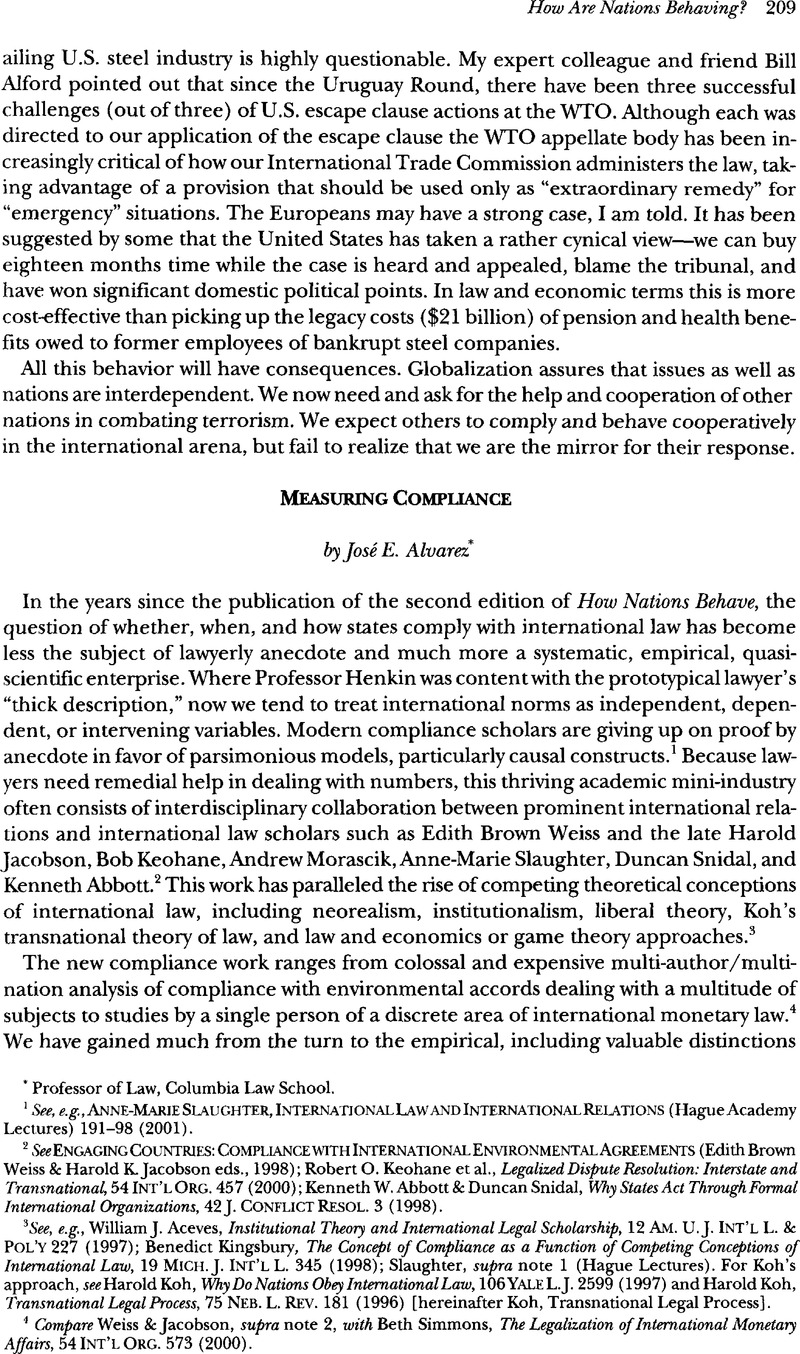No CrossRef data available.
Article contents
Measuring Compliance
Published online by Cambridge University Press: 28 February 2017
Abstract

- Type
- How Are Nations Behaving?
- Information
- Copyright
- Copyright © American Society of International Law 2002
References
1 See, e.g., Anne-Marie Slaughter, International Law and International Relations (Hague Academy Lectures) 191-98 (2001).
2 See Engaging Countries: Compliance with International Environmental Agreements (Edith Brown Weiss & Harold Jacobson eds., 1998); Keohane, Robert O. et al., Legalized Dispute Resolution: Interstate and Transnational, 54 Int’l Org. 457 (2000)CrossRefGoogle Scholar; Abbott, Kenneth W. & Snidai, Duncan, Why States Act Through Format International Organizations, 42 J. Conflict Resol. 3 (1998)CrossRefGoogle Scholar.
3 See, e.g., Aceves, William J., Institutional Theory and International Legal Scholarship, 12 Am. U. J. Int’l L. & Pol’y 227 (1997)Google Scholar; Kingsbury, Benedict, The Concept of Compliance as a Function of Competing Conceptions of International Law, 19 Mich. J. Int’l L. 345 (1998)Google Scholar; Slaughter, supra note 1 (Hague Lectures). For Koh’s approach, see Koh, Harold, Why Do Nations Obey International Law, 106 Yale L.J. 2599 (1997)CrossRefGoogle Scholar and Koh, Harold, Transnational Legal Process, 75 Neb. L. Rev. 181 (1996)Google Scholar [hereinafter Koh, Transnational Legal Process].
4 Compare Weiss & Jacobson, supra note 2, with Simmons, Beth, The Legalization of International Monetary Affairs, 54 Int’l Org. 573 (2000)Google Scholar.
5 Weiss and Jacobson, supra note 2.
6 See, e.g., Sweet, Alec Stone, Judicialization and the Construction of Governance, 32 Comp. Pol. Stud. 147 (1999)Google Scholar; Cass, Deborah Z., The ‘Constitutionalization’ of International Trade Law, 12 Eur. J. Int’l L. 39 (2001)CrossRefGoogle Scholar.
7 See, e.g., Trachtman, Joel P., The Domain of WTO Dispute Resolution, 40 Harv. Int’l L. J. 333 (1999)Google Scholar.
8 See Koh, Transnational Legal Process, supra note 3.
9 See, e.g., Snidai, Duncan, The Game Theory of International Politics, 38 World Pol. 25 (1985)Google Scholar; Aceves, supra note 3.
10 Compare Churchill, Robin R. & Ulfstein, Geir, Autonomous Institutional Arrangements in Multilateral Environoment Agreements; A Little-Noticed Phenomenon in International Law, 94 AJIL 623 (2000)CrossRefGoogle Scholar and Abram Chayes & Antonia Chayes, The New Sovereignty (1995) with Downs, George et al., The Transformative Model of International Regime Design: Triumph of Hope or Experience, 38 Colum. J. Transnat’l L. 465 (2000)Google Scholar.
11 See, e.g., Commitment and Compliance (Dinah Shelton, ed. 2000).
12 Compare Chayes & Chayes, supra note 10, with Downs et al., supra note 10; see also Henry J. Steiner, Individual Claims in a World of Massive Violations, in the Future of UN Human Rights Treaty Monitoring 15 (Philip Alston & James Crawford eds., 2000) (suggesting reforms for the Human Rights Committee that would make than entity operate less like a court); 5«« also Heifer, Laurence R. & Slaughter, Anne-Marie, Toward a Theory of Supranational Adjudication, 107 Yale L.J. 273 (1997)Google Scholar (suggesting changes to the Human Rights Committee to bring its operation closer to that of the European Court of Human Rights).
13 Weiss & Jacobson, supra note 2.
14 See, e.g., Slaughter, Anne-Marie, International Law in a World of Liberal States, 6 Eur. J. Int’l L. 503 (1995)Google Scholar; Dixon, William J., Democracy and the Management of International Conflict, 37 J. Confict. Resol. 42 (1993)Google Scholar; Michael Doyle, W., Liberalism and World Politics, 80 Am. Pol. Sci. Rev. 1151 (1986)CrossRefGoogle Scholar; Raymund, Gregory A., Democracies, Disputes and Third-Party Intermediaries, 38 J. Conflict Resol. 24 (1994)Google Scholar. For a critical view of this aspect of liberal theory, see Alvarez, José E., Do Liberal States Behave Better? 12 Eur. J. Int’l L. 183 (2001)Google Scholar.
15 Keohane et al., supra note 2.
16 See, e.g., Alter, Karen J., The European Union’s Legal System and Domestic Policy, 54 Int’l Org. 489 (2000)CrossRefGoogle Scholar.
17 Hathaway, Oona A., Do Treaties Make a Difference? 111 Yale L.J. 1935 (2002)CrossRefGoogle Scholar.
18 Id.
19 See, e.g. Checkel, Jeffrey T., Why Comply ? Social Learning and European Identity Change, 55 Int’l Org. 553 (2001)Google Scholar; Parsons, Craig, Showing Ideas as Causes: The Origins of the European Union, 56 Int’l Org. 47 (2002)CrossRefGoogle Scholar.
20 See, e.g., Snyder, Jack, Anarchy and Culture: Insights from the Anthropology of War, 56 Int’l Org. 7 (2002)CrossRefGoogle Scholar (drawing on anthropological studies for the insight that the behavior of states is shaped by the interaction of numerous material, institutional, and cultural/ideational factors and that predictions as to likely outcomes cannot be determined simply by adding up the effects of each of these elements); Parsons, supra note 19 (arguing that the European Union has structural, institutional, and ideational roots).
21 For a survey of these, see Simmons, Beth A., Compliance with International Agreements, 1 Ann. Rev. Pol. Sci. 75 (1998)Google Scholar.
22 Simmons, supra note 4.
23 See, e.g., Douglass, Cassel, Does International Human Rights Law Make a Difference? 2 Chi J. Int’l L. 121 (2001)Google Scholar.




